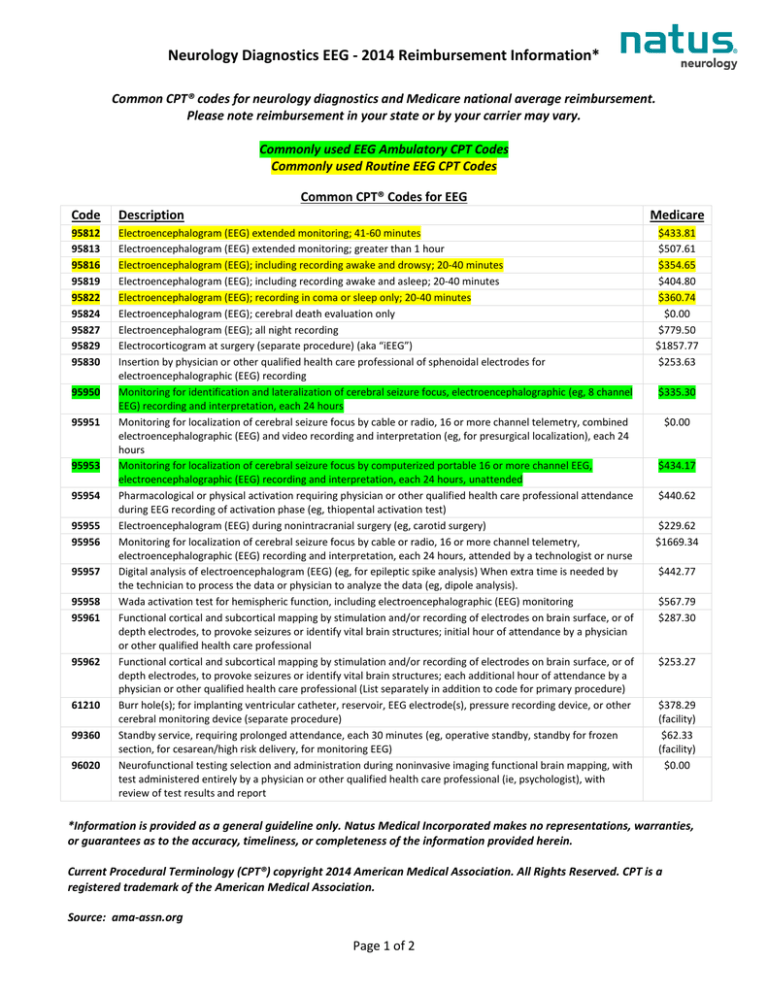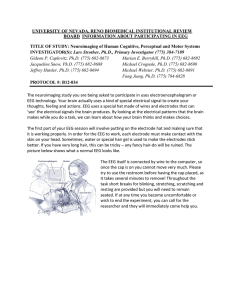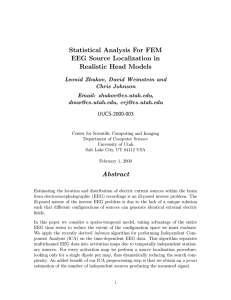
Neurology Diagnostics EEG - 2014 Reimbursement Information*
Common CPT® codes for neurology diagnostics and Medicare national average reimbursement.
Please note reimbursement in your state or by your carrier may vary.
Commonly used EEG Ambulatory CPT Codes
Commonly used Routine EEG CPT Codes
Common CPT® Codes for EEG
Code
Description
95812
95813
95816
95819
95822
95824
95827
95829
95830
Electroencephalogram (EEG) extended monitoring; 41-60 minutes
Electroencephalogram (EEG) extended monitoring; greater than 1 hour
Electroencephalogram (EEG); including recording awake and drowsy; 20-40 minutes
Electroencephalogram (EEG); including recording awake and asleep; 20-40 minutes
Electroencephalogram (EEG); recording in coma or sleep only; 20-40 minutes
Electroencephalogram (EEG); cerebral death evaluation only
Electroencephalogram (EEG); all night recording
Electrocorticogram at surgery (separate procedure) (aka “iEEG”)
Insertion by physician or other qualified health care professional of sphenoidal electrodes for
electroencephalographic (EEG) recording
Monitoring for identification and lateralization of cerebral seizure focus, electroencephalographic (eg, 8 channel
EEG) recording and interpretation, each 24 hours
Monitoring for localization of cerebral seizure focus by cable or radio, 16 or more channel telemetry, combined
electroencephalographic (EEG) and video recording and interpretation (eg, for presurgical localization), each 24
hours
Monitoring for localization of cerebral seizure focus by computerized portable 16 or more channel EEG,
electroencephalographic (EEG) recording and interpretation, each 24 hours, unattended
Pharmacological or physical activation requiring physician or other qualified health care professional attendance
during EEG recording of activation phase (eg, thiopental activation test)
Electroencephalogram (EEG) during nonintracranial surgery (eg, carotid surgery)
Monitoring for localization of cerebral seizure focus by cable or radio, 16 or more channel telemetry,
electroencephalographic (EEG) recording and interpretation, each 24 hours, attended by a technologist or nurse
Digital analysis of electroencephalogram (EEG) (eg, for epileptic spike analysis) When extra time is needed by
the technician to process the data or physician to analyze the data (eg, dipole analysis).
Wada activation test for hemispheric function, including electroencephalographic (EEG) monitoring
Functional cortical and subcortical mapping by stimulation and/or recording of electrodes on brain surface, or of
depth electrodes, to provoke seizures or identify vital brain structures; initial hour of attendance by a physician
or other qualified health care professional
Functional cortical and subcortical mapping by stimulation and/or recording of electrodes on brain surface, or of
depth electrodes, to provoke seizures or identify vital brain structures; each additional hour of attendance by a
physician or other qualified health care professional (List separately in addition to code for primary procedure)
Burr hole(s); for implanting ventricular catheter, reservoir, EEG electrode(s), pressure recording device, or other
cerebral monitoring device (separate procedure)
Standby service, requiring prolonged attendance, each 30 minutes (eg, operative standby, standby for frozen
section, for cesarean/high risk delivery, for monitoring EEG)
Neurofunctional testing selection and administration during noninvasive imaging functional brain mapping, with
test administered entirely by a physician or other qualified health care professional (ie, psychologist), with
review of test results and report
95950
95951
95953
95954
95955
95956
95957
95958
95961
95962
61210
99360
96020
Medicare
$433.81
$507.61
$354.65
$404.80
$360.74
$0.00
$779.50
$1857.77
$253.63
$335.30
$0.00
$434.17
$440.62
$229.62
$1669.34
$442.77
$567.79
$287.30
$253.27
$378.29
(facility)
$62.33
(facility)
$0.00
*Information is provided as a general guideline only. Natus Medical Incorporated makes no representations, warranties,
or guarantees as to the accuracy, timeliness, or completeness of the information provided herein.
Current Procedural Terminology (CPT®) copyright 2014 American Medical Association. All Rights Reserved. CPT is a
registered trademark of the American Medical Association.
Source: ama-assn.org
Page 1 of 2
Neurology Diagnostics EEG - 2014 Reimbursement Information*
Q: What is the difference between 95816 (EEG recording including awake and drowsy) and code 95819
(EEG recording including awake and asleep)?
A: The answer is that to use 95819 the patient must have fallen asleep and if not 95816 should be
used. However, the line between drowsy and asleep can often be difficult to determine and it is
permissible to use 95819 if a sleep study was intended, but, despite the best efforts of the technician,
sleep was not obtained.
Source: https://www.aan.com/practice/billing-and-coding/coding-faqs/ (Must log-in as an active AAN member.)
Q: What is the minimum number of channels or electrodes to be used in order to report codes 95812,
95813, 95955 and 95822?
A: One has to meet the minimum technical standards for an EEG test, not only with a minimum of 20
minutes of monitoring, but with a minimum of eight channels and other rules as set forth by national
organizations such as the American Clinical Neurophysiology Society.
Q: When should I not use Code 95957? When do I use Code 95957?
A: Code 95957 should not be used simply when the EEG was recorded digitally. There is no additional
charge for turning on an automated spike and seizure detector on a routine EEG, ambulatory EEG, or
video-EEG monitoring. Nor is there an additional code for performing EEG on a digital machine instead
of an older generation analog machine. Some features of digital EEG make it easier and quicker to
read, and other features slow it down by providing new optional tricks and tools. Overall, it is about
the same amount of work as an analog EEG.
Code 95957 is used when substantial additional digital analysis was medically necessary and was
performed, such as 3D dipole localization. In general, this would entail an extra hour's work by the
technician to process the data from the digital EEG, and an extra 20-30 minutes of physician time to
review the technician's work and review the data produced.
Most practitioners would not have the opportunity to do this advanced procedure. It would be more
commonly used at specialty centers, e.g. epilepsy surgery programs. Note that the codes for
"monitoring for identification and lateralization of cerebral seizure focus" already include epileptic
spike analysis.
Source: https://www.aan.com/practice/billing-and-coding/coding-faqs/ (Must log-in as an active AAN member.)
Q: Where can I find ICD-10-CM diagnosis coding information?
A: http://www.icd10data.com/
007219, RevC
Page 2 of 2



